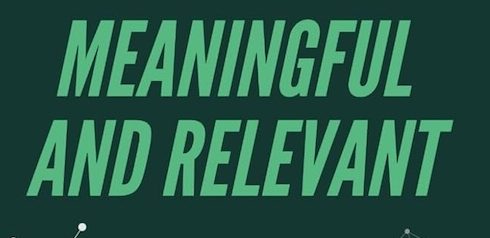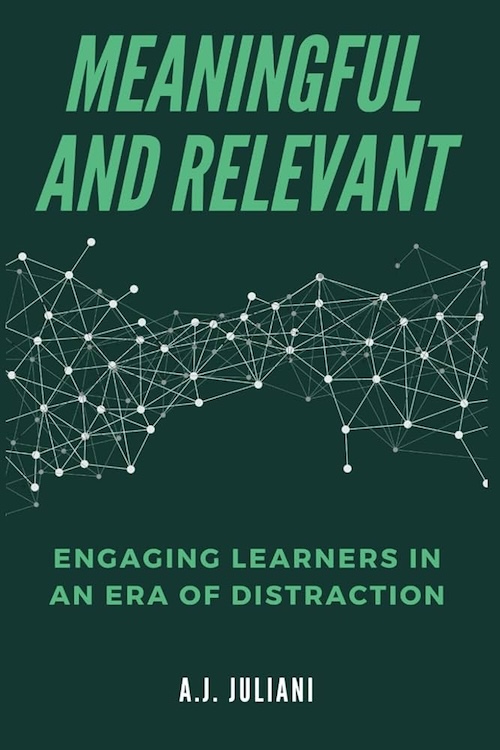
Oh man! Student responses sometimes punch me in the gut! Polished but lifeless—fingerprints of ChatGPT without personal engagement, no wrestling with ideas, no sign the student ever sat with the material long enough to make it their own. It’s as if the goal of education has become to paste a prompt, collect a passable response, and move on. I can’t blame them entirely—the system has long rewarded efficiency over reflection—but it leaves me wondering: What does it take for students to truly care about their learning? For me, the answer has become clearer. And A.J. Juliani teases out these factors into key principles in Meaningful and Relevant: Engaging Learners in an Era of Distraction: ownership—students need to see their fingerprints on the work; connection—the sense that what they create matters beyond a grade; and choice, because without agency, caring rarely takes root. Learning requires meaning and relevance. When these pieces are present, shortcuts lose their appeal, and genuine engagement becomes seductive. His roadmap is ambitious, hopeful, sometimes idealistic, but for anyone who has felt that sting of disengagement on the other side of the screen, his message feels urgent.
Juliani argues we’re living at a “hinge of history.” Schools were built for an analog world of scarce information and predictable paths, while today’s students grow up immersed in a hyper-connected one where their tools, habits, and identities are shaped differently. Employers want to know what potential employees can offer not at the level or AI but beyond. While many respond with bans or tighter control, Juliani flips the script: design learning so compelling that attention follows naturally. His mantra: attention is earned, not demanded.
He sharpens this by distinguishing between meaningful and relevant learning—and here’s where the ideas move from head to heart. When students feel their pulse quicken because the work connects with who they are, they stop asking, “Will this be on the test?” Meaningful taps identity and purpose—it feels worth doing for its own sake. Relevant connects directly to life outside the classroom, answering: Why should I care about this? Juliani argues this answer often comes through community—in giving students voice and authentic audiences for their work. Together, these create deeper investment and make shortcuts less appealing.
Juliani is strongest when showing what this looks like in practice. Drawing on design thinking, Universal Design for Learning, and project-based learning, he offers strategies that emphasize agency and authenticity. He uses the metaphor of a “buffet-style” lesson, where choice isn’t a decorative add-on but a way of structuring learning so students enter through paths that align with their identities and motivations—choice as a gateway to meaning, relevance, and flow. Layered with the psychology of flow, Schlechty’s engagement levels, and tools like inquiry cycles and authentic audiences, the book becomes part field guide, part pep talk, and part reminder that curiosity is contagious when we design with care.
The chapters on artificial intelligence stand out for their nuance. Juliani doesn’t see AI tools like ChatGPT or Photomath as threats to originality, but as invitations to rethink assessment. If we only value the final product, machines outpace us. If we value reflection and voice, AI has limits.
Juliani sketches bold visions and weaves stories from classrooms he’s worked with. His examples—though often simple anecdotes—become springboards for reflection, urging us to imagine how we can bring greater meaning and relevance into our own teaching spaces. Rather than leaving me skeptical or defeated, these moments left me inspired to see new possibilities for engaging learners.
Juliani reminds us that joy, curiosity, and persistence are not happy accidents; they are designed for, nurtured, and expected.
Meaningful and Relevant is not a recipe book—it’s a call to reimagine the kitchen. Juliani wants us to stop tinkering at the edges of compliance and instead design with meaning and relevance at the core. His vision is bold, sometimes frustratingly idealistic as it pinches the fat we would rather ignore, but deeply necessary. As he puts it: “Our job is not to prepare students for something. Our job is to help students prepare themselves for anything.”
To me, this challenge isn’t only about changing the student experience—it’s also about us—how we design and engage with assignments ourselves. When efficiency weighs too heavily on the balance, we risk slipping into the same shallow patterns we warn our students against. So I have to ask: are my assignments built to spark authentic engagement with students, or do they quietly default to efficiency in grading?





